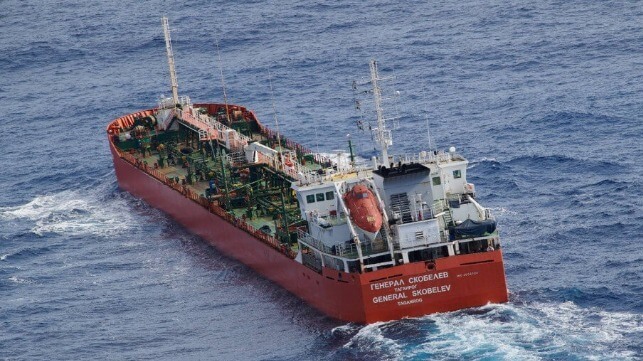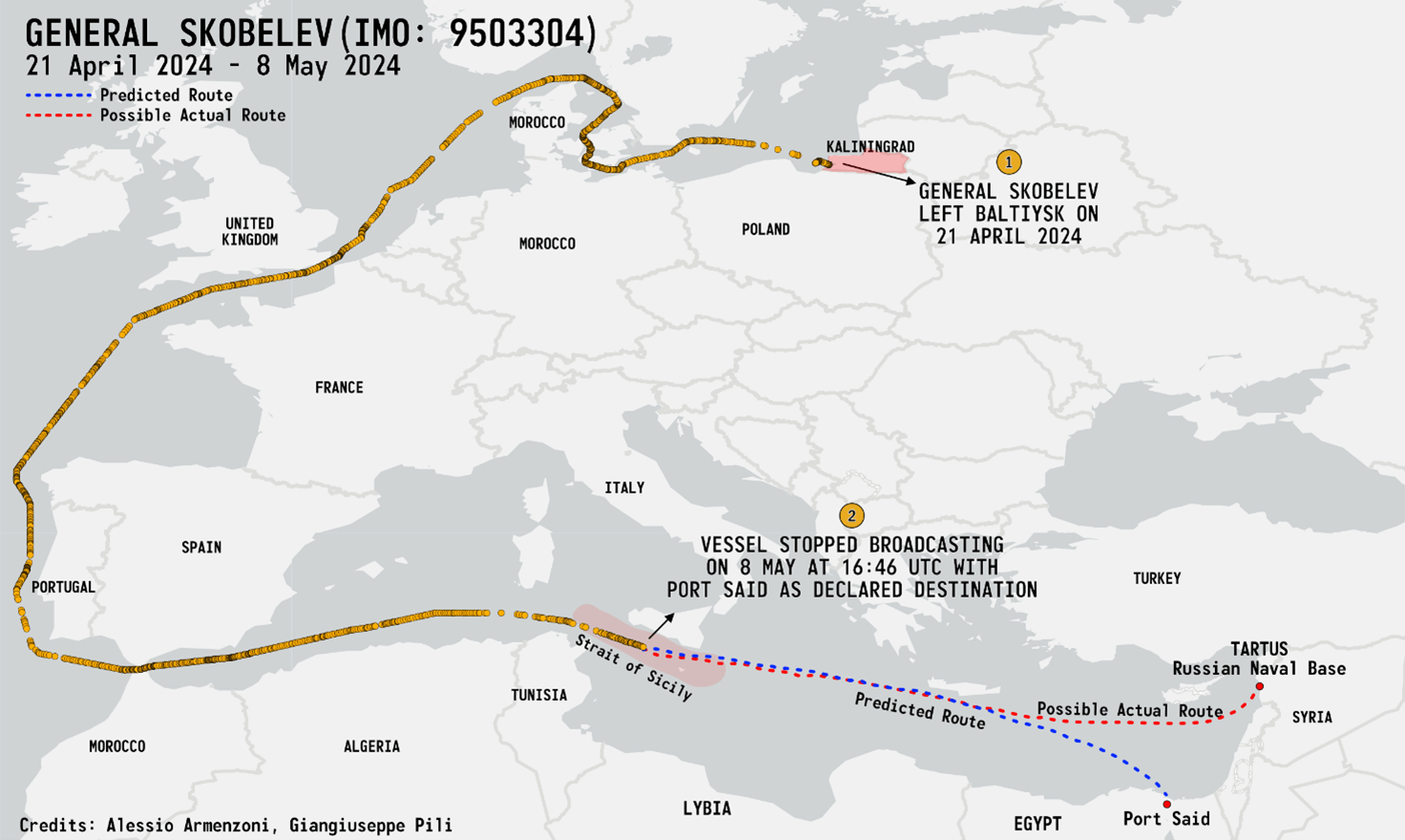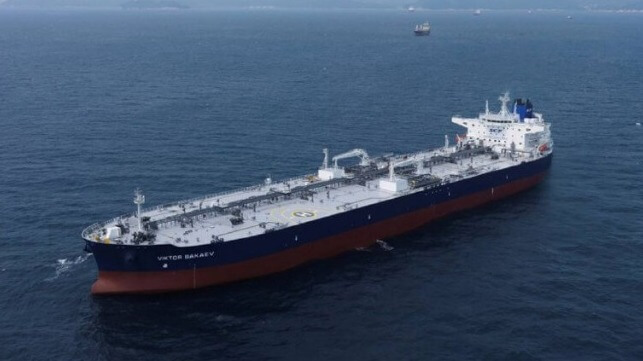After Close Scrutiny, Russian "Ghost Fleet" Ships May Be Changing Tactics

After the attention paid to the sanctioned freighter Sparta IV and other ships in the "Ghost Fleet", Russia’s covert military logistics vessels may be starting to get more cautious. A ship known to OSINT analysts, the Russian-flagged oil tanker General Skobelev (IMO: 9503304), departed from Baltyisk, Russia, on April 21, with a declared destination of Port Said, Egypt. It may have stopped its AIS transmission in the middle of the Sicilian Channel on May 8, a week ago.
Maritime OSINT analyst RussianForcesSpotter pointed out on X that “civilian” tankers were being escorted in the English Channel by the Russian frigate Neustrashimy, which is assigned to the Baltic Fleet and stationed in Baltyisk. Later, the Russian frigates Grigorovich, Merkuriy and Kildin departed from the Russian naval base of Tartus, Syria, heading west, possibly to meet and escort General Skobelev. After this, General Skobelev appears to have stopped its transmission, going dark in the middle of the Strait of Sicily.
 Fig. 1: General Skobelev's route from April 21 to May 8, 2024. Sources: AIS data provided by Global Fishing Watch, annotated by the authors.
Fig. 1: General Skobelev's route from April 21 to May 8, 2024. Sources: AIS data provided by Global Fishing Watch, annotated by the authors.
After almost a week, General Skobelev is still missing and it is unclear where it is heading to at this point, though it is worth noting that there is an established presence in Tartus, Syria. Historically, Russian ships sailing to military bases in Syria are reported to possibly turn their AIS off close to the final destination. This time, perhaps because of the timely observations of multiple, independent marine OSINT trackers, there could be an adaptation in tactics.
Giangiuseppe Pili (Ph. D.) is an Assistant Professor in the Intelligence Analysis Program at James Madison University. He is an Associate Fellow at Open Source Intelligence and Analysis at the Royal United Services Institute.
Alessio Armenzoni is a geospatial intelligence analyst working on projects related to maritime security. He studied at the Centre for Higher Defense Studies from the Italian MoD.
The opinions expressed herein are the author's and not necessarily those of The Maritime Executive.
Report: Indian Class Withdrawn on Sanctioned Russian Tankers

Russian shipping interests continue to shuffle around the registry details of their large crude tankers in an apparent effort to address the Western sanctions on vessels. Reuters conducted an analysis and found that 12 of the 14 tankers listed by the United States in February 2024 have been moved to the Russian Maritime Register of Shipping, some having changed class societies or flags twice in a matter of months.
The U.S. and its allies in the G7 reported at the end of February they were moving against both Russian shipping company Sovcomflot and tankers that had regularly transported oil in violation of the price cap imposed by the West as a punishment for the invasion of Ukraine. The U.S. blocked 14 tankers controlled by Sovcomflot on February 28. Before that, they had listed 20 tankers being run through third-party management companies in locations such as Dubai and elsewhere.
The review of the databases conducted by Reuters shows the Indian Register of Shipping which had stepped in to class the ships now shows 12 of the tankers with the notations class withdrawn. The vessels are appearing in the Russian Maritime Register with new names. Flags on the vessels also appear to have been shifted to Russia.
The shell game with the vessels shuffling them between flags and class societies is so complicated most databases have not yet caught up with the vessels. Some of the vessels, such as the NS Bravo (IMO:9412359) is now the Belgorod having entered Russian class as of April. The well-known Equasis database reflects the ship had been in the Liberian registry since it was built in 2010 until January 2024 when it shifted to Gabon and now in April to Russia.
Most of the vessels identified in the report by Reuters show a similar history. Most moved into the Gabon registry earlier this and now over the Russian flag. The tanker Sakhalin Island appears to have been in the Panama registry until moving to the Russian flag.
The United States had a dialog with the officials in Panama seeking to win their support to clampdown on more of the tankers violating sanctions. American officials reported they encouraged Panama to continue efforts to withdraw registry from vessels violating the sanctions.
The report that the Indian Registry had withdrawn vessels goes counter to a report last month that India had provided access to insurance for the Russian vessels. India’s refineries appeared to stop imports on Russian vessels fearing the sanctions but resumed the imports in April.
Reports have said that Russia wants to keep the exports on its own tankers to earn the transportation fees. However, the shadow fleet of tankers also continues to grow.
In recent days there have been numerous reports that the EU and the UK are looking at new sanctions. Among the steps being prepared by the EU are moves against Russian LNG exports while the UK Treasury is investigating steps against price cap violators.
The U.S. continues to also impose ever-increasing rounds of sanctions including a massive wave at the beginning of May against the Russian oil sector. It continues to be a back-and-forth effort with Russia shuffling around the assets and the West trying to close loopholes and snare more individuals and ships.
No comments:
Post a Comment